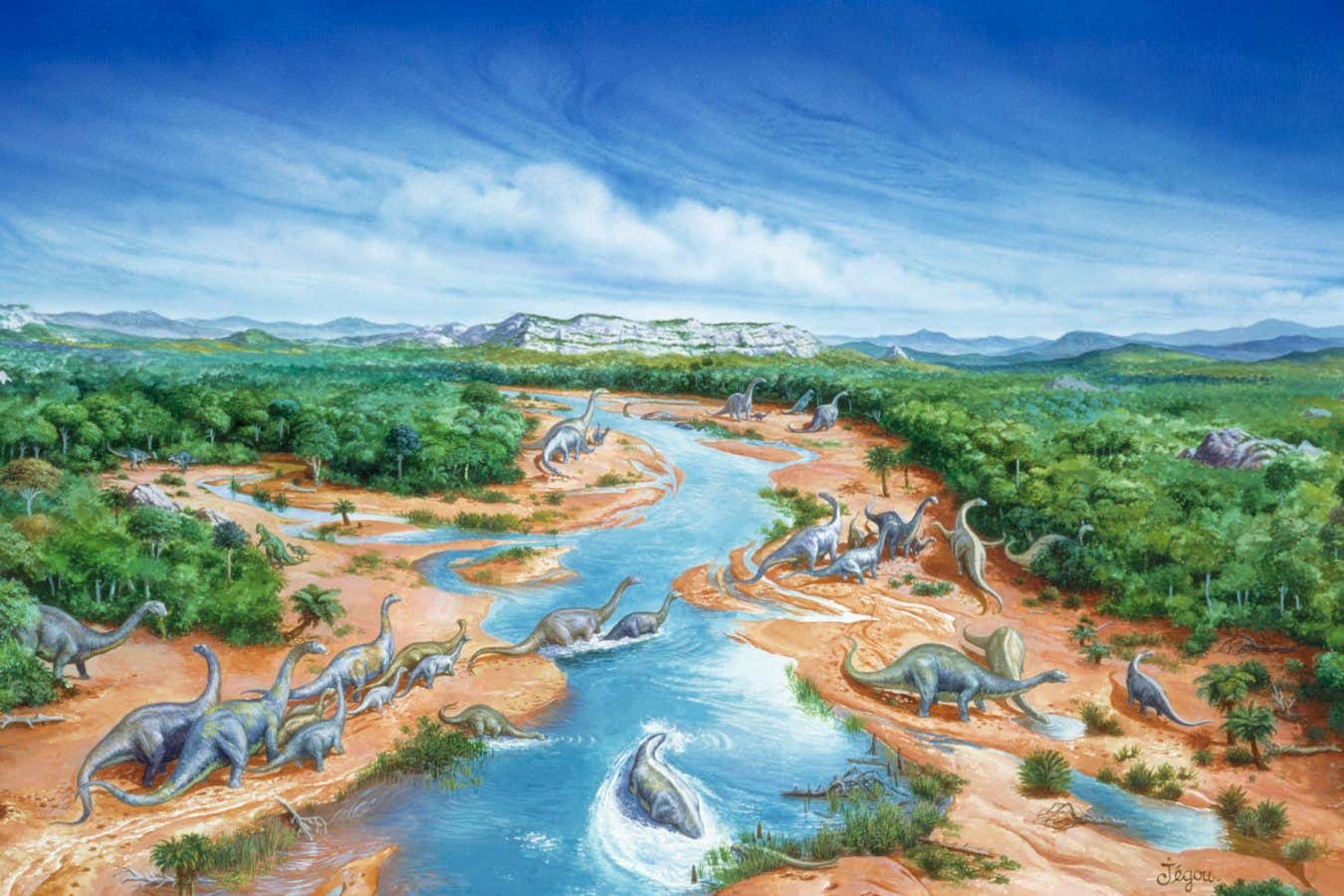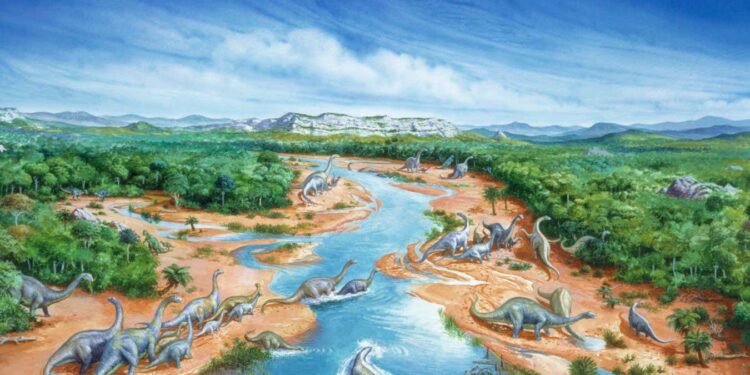
Large dinosaurs like titanosaurs would have had a huge impact on their environment
CHRISTIAN JEGOU/SCIENCE PHOTO LIBRARY
The impact dinosaurs had on Earth was so big that their extinction seems to have caused dramatic and wide-ranging changes to the planet’s landscapes, such as shifting rivers.
There is a marked difference between some rock formations in North America before and after the dinosaurs died out in the Cretaceous–Paleogene (K–Pg) extinction event some 66 million years ago, after the Chicxulub asteroid slammed into the Yucatán peninsula.
For instance, green-grey mudstone of what is known as the Hell Creek formation from the time of the dinosaurs turns into the Fort Union formation’s more colourful pyjama-striped layers that contain lots of lignite, a low-grade form of coal formed from plant matter, as the rise of mammals begins.
The changes have previously been put down to the direct knock-on effects of the asteroid strike, including increased precipitation, but Luke Weaver at the University of Michigan and his colleagues are suggesting a different cause.
They have examined sites – largely river floodplains – in the western US that display the sudden geological changes that occurred around the K-Pg boundary, in Bighorn basin in Wyoming and in the Williston basin, spanning parts of Montana and North and South Dakota.
The different colourful layers of the post-dinosaur times were thought to be deposits formed as water levels increased, creating transient ponds. But Weaver and his colleagues could find no evidence in the literature of a change in water levels at this time.
“There’s already [a] very high water table, very wet conditions, and there’s no evidence for increased precipitation,” he says. Although there were inland transgressions of seawater, the closest one was at least 300,000 years after the K-Pg boundary, he says.
Weaver and his colleagues think some of the key sandstone layers after the K-Pg boundary are deposits that form the inside of a big meander in a river, known as point bar deposits, rather than being pond deposits. They are so thick – some more than 10 metres – because the rivers weren’t transient; they had become stable.
The researchers put this down to the dinosaurs’ disappearance. They suggest that, like big herbivores today, dinosaurs were ecosystem engineers, knocking down vegetation and trampling and grazing on saplings, preventing plants from establishing themselves.
“These things were monsters compared to what you have today,” says Weaver. For example, a modern elephant might be around 5000 kilograms, but Triceratops could be at least twice as heavy, he says.
While they roamed, knocking down vegetation, this meant rivers flooded regularly, says Weaver, and didn’t meander around forests. This ultimately created huge expanses of boggy mudstone, he says, but once the dinosaurs were gone, the roots of trees trapped and stabilised the sediment, corralling the water into rivers with broad meanders, creating point bars.
“This isn’t an instance of the landscape just being the stage upon which biology is taking place,” says Weaver. The animals are altering the environment, he says, and he draws parallels with the way people have quickly and dramatically changed Earth’s landscape.
Christopher Doughty at Northern Arizona University thinks the idea fits the observed changes in geology better than previous hypotheses. “We see large increases in tree cover in modern studies where large animals are removed from ecosystems,” he says. “Upon the extinction of the dinosaurs, there would no longer have been animals with the size and strength to uproot large trees. There would have been less herbivory and large footsteps crushing samplings. All this would have allowed trees to flourish.”
Kat Schroeder at Yale University is yet to be convinced, however. “While there does seem to be at least some correlation with large dinosaurs and open vegetative landscapes, causation has yet to be shown,” she says. “Forests flourished before, during and after the age of the dinosaurs.”
Doughty says using isotopic data from fossil leaves to see how forest structure changed following the extinctions could help verify or disprove the idea.

Dinosaur hunting in the Gobi desert, Mongolia
Embark on an exhilarating and one-of-a-kind expedition to uncover dinosaur remains in the vast wilderness of the Gobi desert, one of the world’s most famous palaeontological hotspots.
Topics:
Source link : https://www.newscientist.com/article/2496215-the-death-of-dinosaurs-dramatically-re-engineered-earths-landscapes/?utm_campaign=RSS%7CNSNS&utm_source=NSNS&utm_medium=RSS&utm_content=home
Author :
Publish date : 2025-09-15 10:43:00
Copyright for syndicated content belongs to the linked Source.














